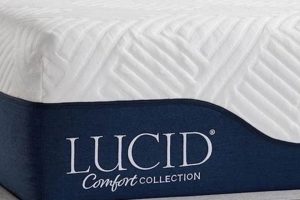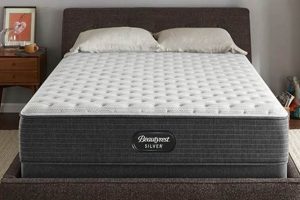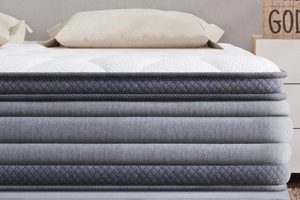A standard mattress dimension, wider than a twin yet smaller than a queen, offers a sleeping surface suited for individuals or couples who desire more space than a single bed provides but do not require the expansive area of larger mattress formats. Typically measuring around 54 inches wide and 75 inches long, this format accommodates growing teenagers or single adults comfortably.
The value of this mattress dimension lies in its space efficiency, balancing sleep area with room footprint. Its historical context reflects evolving residential construction, fitting proportionally within bedrooms of varying sizes. The selection of this mattress format can significantly affect sleep quality and overall bedroom functionality, contributing to both physical rest and environmental ergonomics.
The subsequent discussion will delve into the specifications, common uses, and factors to consider when selecting this particular mattress dimension, providing a detailed overview to inform purchasing decisions.
Guidance on Selecting a Mattress of this Dimension
The following offers guidance for individuals and couples seeking to acquire a mattress conforming to standard dimensional specifications, focusing on key considerations before purchase.
Tip 1: Assess Occupancy Needs: Determine whether the mattress will primarily accommodate a single individual or a couple. This assessment directly informs the sufficiency of the sleep surface area. A single sleeper may find ample room, while two individuals might experience limited space, especially if either moves frequently during sleep.
Tip 2: Measure Room Dimensions: Precisely measure the available bedroom space to ensure the mattress does not unduly restrict movement or access to other furniture. Account for peripheral elements like nightstands and dressers, maintaining accessible pathways.
Tip 3: Evaluate Body Size: Consider the height and weight of the intended sleepers. Taller individuals may find the standard 75-inch length inadequate, leading to discomfort. Similarly, heavier individuals may necessitate a mattress with reinforced support to prevent sagging and maintain optimal spinal alignment.
Tip 4: Examine Mattress Construction: Investigate the materials and construction techniques employed in the mattress. Foam, innerspring, hybrid, and latex mattresses offer varying levels of support, comfort, and durability. Select a construction that aligns with individual sleep preferences and orthopedic needs.
Tip 5: Review Support System: Analyze the mattress’s support system, particularly focusing on edge support. Adequate edge support prevents roll-off and expands the usable sleep surface, which is crucial when the available width is less substantial.
Tip 6: Inquire About Sleep Trials: Seek vendors that offer sleep trials. These allow prospective buyers to test the mattress in their home environment for a specified period, providing a realistic assessment of comfort and suitability.
Tip 7: Check Warranty Details: Carefully review the warranty terms. A comprehensive warranty indicates manufacturer confidence and protects against premature defects, such as sagging, indentations, or component failures.
By carefully considering these points, potential buyers can select a mattress that adequately fulfills their sleep needs and contributes positively to bedroom ergonomics and overall well-being.
The subsequent section will discuss suitable bed frames and bedding accessories complementing this mattress format.
1. Dimensions
The specification “Dimensions: 54″ x 75″” is foundational to understanding the nature of a particular mattress standard. This measurement precisely defines its spatial footprint and, consequently, its suitability for various sleeping arrangements and room sizes. A detailed examination of these dimensions reveals key facets of this mattress classification.
- Surface Area Considerations
The surface area defined by 54 inches in width and 75 inches in length dictates the amount of space available for sleep. This is particularly relevant for determining comfort levels for single adults and, marginally, for couples. Inadequate surface area can lead to disrupted sleep cycles and reduced overall sleep quality. For example, an individual who frequently changes sleeping positions may find this mattress dimension restrictive.
- Room Size Compatibility
The dimensions must be evaluated relative to available bedroom space. A 54″ x 75″ mattress is often a compromise between maximizing sleeping surface and minimizing room intrusion. In smaller bedrooms, larger mattresses could compromise mobility and overall room functionality. It serves as a practical solution where space is a primary constraint.
- Bed Frame Compatibility
The standardized nature of these dimensions ensures compatibility with a wide array of bed frames specifically designed for this format. This compatibility simplifies the purchasing process and guarantees a secure and proper fit. However, variations in frame construction can subtly alter the overall dimensions, impacting the perceived space and stability of the mattress.
- Linen Availability
Due to the commonality of this dimension, appropriate linens, including sheets, comforters, and mattress protectors, are readily available and typically cost-effective. This widespread availability reduces the cost and complexity associated with outfitting the bed for use. Specialized or custom-sized linens are unnecessary, contributing to overall convenience.
The collective implications of the 54″ x 75″ dimensions underscore its role as a mid-range option balancing size, space efficiency, and cost. The characteristics detailed above clarify the practical considerations inherent in choosing this mattress standard, particularly for individuals seeking a comfortable yet space-conscious sleep solution.
2. Suitable Occupancy
The term “suitable occupancy,” when related to a specific mattress dimension, directly influences the sleeping experience and overall satisfaction. A mattress of these dimensions provides a defined sleep surface that inherently limits the number of occupants it can comfortably accommodate. The correlation between the dimensions and the intended number of sleepers is a primary determinant of sleep quality. For instance, a single adult typically finds the space adequate, allowing for freedom of movement during sleep. In contrast, two adults sharing the same area may experience restricted space, leading to potential sleep disturbances due to proximity and motion transfer.
The selection of this mattress dimension necessitates a careful evaluation of occupant needs. Factors like body size, sleeping habits (e.g., tossing and turning), and personal preferences regarding personal space play crucial roles. A mattress too small for its occupants can result in discomfort, disrupted sleep cycles, and even physical ailments such as back pain, due to inadequate support and restricted sleeping positions. Real-life examples include a couple regularly waking each other due to limited space, or a single individual feeling confined by the mattress width, thereby highlighting the detrimental effects of improper occupancy.
In summary, “suitable occupancy” is a critical component of mattress selection. Failure to accurately assess the number and characteristics of the intended sleepers can lead to compromised sleep quality and decreased user satisfaction. The practical significance of this understanding lies in promoting informed decision-making, ensuring that the selected mattress adequately meets the sleep needs of its intended occupants, thereby contributing to improved rest and overall well-being. Ignoring suitable occupancy can lead to wasted investment, discomfort, and long-term health implications related to poor sleep.
3. Space Optimization
The concept of “space optimization” is intrinsically linked to the selection of a specific mattress dimension. This mattress format, measuring 54″ x 75″, offers a strategic compromise between providing adequate sleeping surface and conserving room space. The inherent cause and effect relationship is that smaller rooms necessitate smaller mattresses, and this mattress type often serves as the solution. The importance of “space optimization” becomes pronounced in urban living environments or apartments where square footage is limited. Real-life examples include studio apartments where fitting a queen or king-sized mattress would severely restrict movement and functionality, making this dimension a more practical choice. The practical significance of understanding this relationship lies in enabling informed purchasing decisions, ensuring that the selected mattress enhances, rather than hinders, the overall usability and aesthetic of the bedroom.
Further analysis reveals that the selection of a mattress with space optimization in mind also impacts furniture arrangement and storage options. With more free floor space, individuals have increased flexibility in positioning dressers, nightstands, and other essential bedroom furnishings. Moreover, this mattress size may facilitate the inclusion of additional storage solutions, such as under-bed drawers or shelving units, which would be impractical with larger mattress dimensions. Therefore, the initial decision to prioritize space optimization extends beyond the mattress itself, influencing the holistic design and functionality of the entire room.
In conclusion, space optimization is a critical consideration when selecting a mattress, particularly in smaller living spaces. The mattress format provides a viable solution by balancing sleeping comfort with efficient space utilization. The challenge lies in accurately assessing individual sleep needs and available room dimensions to make an informed decision that maximizes both comfort and functionality. This understanding is vital for creating a bedroom environment that promotes restful sleep without compromising living space.
4. Cost Efficiency
The relationship between a particular mattress dimension and cost efficiency is significant due to the direct impact of size on material requirements and manufacturing complexities. This mattress format generally occupies a mid-range price point compared to other standard sizes. The cause-and-effect dynamic is clear: smaller dimensions necessitate fewer raw materials, leading to lower production costs, which, in turn, can translate to reduced retail prices. The importance of cost efficiency as a component of this mattress format lies in its accessibility to a broader consumer base. Real-life examples include budget-conscious individuals or students furnishing apartments who prioritize affordability without sacrificing a reasonable degree of comfort and sleep quality. The practical significance of this understanding empowers consumers to make informed decisions, aligning their mattress selection with both their budgetary constraints and spatial limitations.
Further analysis reveals that cost efficiency extends beyond the initial purchase price. The reduced dimensions often result in lower shipping costs, simplified handling during delivery, and potentially reduced energy consumption for temperature regulation (e.g., less area to cool or heat). Additionally, bedding and accessories, such as sheets and comforters, are typically more affordable for this size compared to larger counterparts. The long-term financial benefits, therefore, accumulate from multiple angles, making this mattress type a fiscally responsible choice for individuals seeking to minimize expenses without compromising on the fundamental need for a sleep surface. The reduced material usage also offers an environmental benefit, aligning with sustainability initiatives.
In conclusion, cost efficiency is a defining characteristic that contributes substantially to the appeal of this mattress dimension. The reduced material requirements, streamlined manufacturing, and lower associated expenses create a value proposition attractive to budget-conscious consumers. The challenge lies in balancing cost considerations with individual comfort preferences and sleep needs, ensuring that affordability does not compromise essential requirements for restful sleep. However, the inherent cost advantages associated with this mattress size cannot be overlooked, positioning it as a practical and economically sound option in the mattress market.
5. Versatile Bedding
The association between “versatile bedding” and a specific mattress size is characterized by the widespread availability and adaptability of linens and accessories designed to fit. A primary cause-and-effect relationship exists: standardized mattress dimensions facilitate the mass production and distribution of compatible bedding products. The importance of “versatile bedding” stems from its capacity to enhance both the aesthetic appeal and functional utility of a specific mattress. For example, individuals can readily find sheets, comforters, mattress protectors, and decorative pillows that precisely match the mattress size, simplifying the bedding selection process and enabling personalized bedroom design. The practical significance of this relationship lies in providing convenience and choice to consumers, ensuring that they can easily find bedding solutions that align with their individual preferences and budgetary constraints.
Further analysis reveals that this particular mattress format benefits significantly from the broad range of bedding options available. The standardization ensures that consumers are not limited by scarcity or specialized sizing requirements, as might be the case with less common mattress dimensions. Moreover, the variety of materials, patterns, and price points within the bedding market enables consumers to tailor their sleep environment according to their specific needs and tastes. For example, those seeking hypoallergenic bedding can readily find suitable options, while those prioritizing luxury can opt for high-thread-count sheets and premium comforters. This degree of customization enhances the overall sleep experience and contributes to greater satisfaction with the mattress purchase.
In conclusion, the availability of versatile bedding is a significant advantage associated with this mattress format. The standardization of size fosters a thriving market for compatible linens and accessories, providing consumers with an extensive array of options to personalize their sleep environment. The challenge lies in navigating the vast selection and choosing bedding products that effectively balance comfort, durability, and aesthetic appeal. However, the inherent versatility of bedding associated with this mattress size undeniably contributes to its overall value proposition and widespread popularity, streamlining the bedding acquisition process and facilitating the creation of a comfortable and visually appealing sleep space.
Frequently Asked Questions About Mattress Dimensions
The following addresses common inquiries and misconceptions surrounding the specifications and appropriate applications of mattresses conforming to standard dimensional specifications. These answers aim to clarify uncertainties and provide objective information for informed decision-making.
Question 1: Is a mattress with these dimensions suitable for two adults?
A mattress measuring approximately 54 inches wide by 75 inches long may accommodate two adults; however, space constraints may arise, especially if either individual is accustomed to significant movement during sleep or possesses a larger body type. It is generally better suited to a single adult or a smaller couple.
Question 2: What are the spatial requirements for incorporating this mattress size into a bedroom?
The minimum recommended room size is 10 feet by 10 feet. This allows for adequate space around the bed, facilitating ease of movement and placement of ancillary furniture items. Smaller rooms may necessitate strategic furniture arrangement to optimize space utilization.
Question 3: How does the cost of this mattress dimension compare to other standard sizes?
This mattress typically costs less than a queen- or king-sized mattress but more than a twin mattress. The pricing reflects the material quantity required and the demand within the mattress market.
Question 4: What is the lifespan expectancy of a mattress of these dimensions?
The lifespan expectancy varies depending on the construction materials and usage patterns. Generally, a mattress conforming to this size, constructed with quality materials, can last between seven to ten years, provided it receives proper care and maintenance.
Question 5: Are there specific weight limitations associated with this mattress size?
Weight limitations vary depending on the internal support structure of the mattress. It is advisable to consult the manufacturer’s specifications to ascertain the maximum weight capacity to prevent premature sagging or structural damage.
Question 6: What type of bed frame is most suitable for this mattress dimension?
A bed frame designed specifically for this mattress is recommended. Slatted frames or those with adequate center support are optimal, ensuring even weight distribution and preventing mattress deformation.
These FAQs provide fundamental knowledge regarding the attributes and practical considerations associated with mattress dimensions. Prospective buyers are encouraged to conduct additional research and consult with sleep specialists to make informed purchasing decisions tailored to individual needs.
The subsequent section will address maintenance and care procedures conducive to prolonging the lifespan and maintaining the hygiene of a mattress of these dimensions.
Conclusion
This exploration has elucidated the multifaceted nature of what constitutes a mattress of a specific dimension. From defining its precise measurements and suitable occupancy to analyzing its space optimization, cost efficiency, and versatile bedding options, this discourse has provided a comprehensive understanding of its attributes and applications. The objective information presented empowers individuals to assess their needs critically and make informed purchasing decisions, factoring in personal circumstances and spatial limitations.
The selection of a mattress format necessitates careful consideration, weighing comfort, space, and budget. Continued advancements in mattress technology and evolving residential trends will likely shape the future demand and design of this particular mattress size. Therefore, ongoing research and informed consumerism remain paramount in ensuring optimal sleep solutions are implemented.


![Best Full Size RV Mattress [Guide] for Cozy RV Sleep Organic & Natural Mattress Buyer’s Guide: Non-Toxic Sleep Solutions Best Full Size RV Mattress [Guide] for Cozy RV Sleep | Organic & Natural Mattress Buyer’s Guide: Non-Toxic Sleep Solutions](https://mattressworldpa.com/wp-content/uploads/2025/07/th-2783-300x200.jpg)


![Best Intex Full Size Inflatable Mattress - [Year] Guide Organic & Natural Mattress Buyer’s Guide: Non-Toxic Sleep Solutions Best Intex Full Size Inflatable Mattress - [Year] Guide | Organic & Natural Mattress Buyer’s Guide: Non-Toxic Sleep Solutions](https://mattressworldpa.com/wp-content/uploads/2025/07/th-2780-300x200.jpg)
![Choosing the Right Bunk Bed Mattress Full Size [Guide] Organic & Natural Mattress Buyer’s Guide: Non-Toxic Sleep Solutions Choosing the Right Bunk Bed Mattress Full Size [Guide] | Organic & Natural Mattress Buyer’s Guide: Non-Toxic Sleep Solutions](https://mattressworldpa.com/wp-content/uploads/2025/07/th-2779-300x200.jpg)
